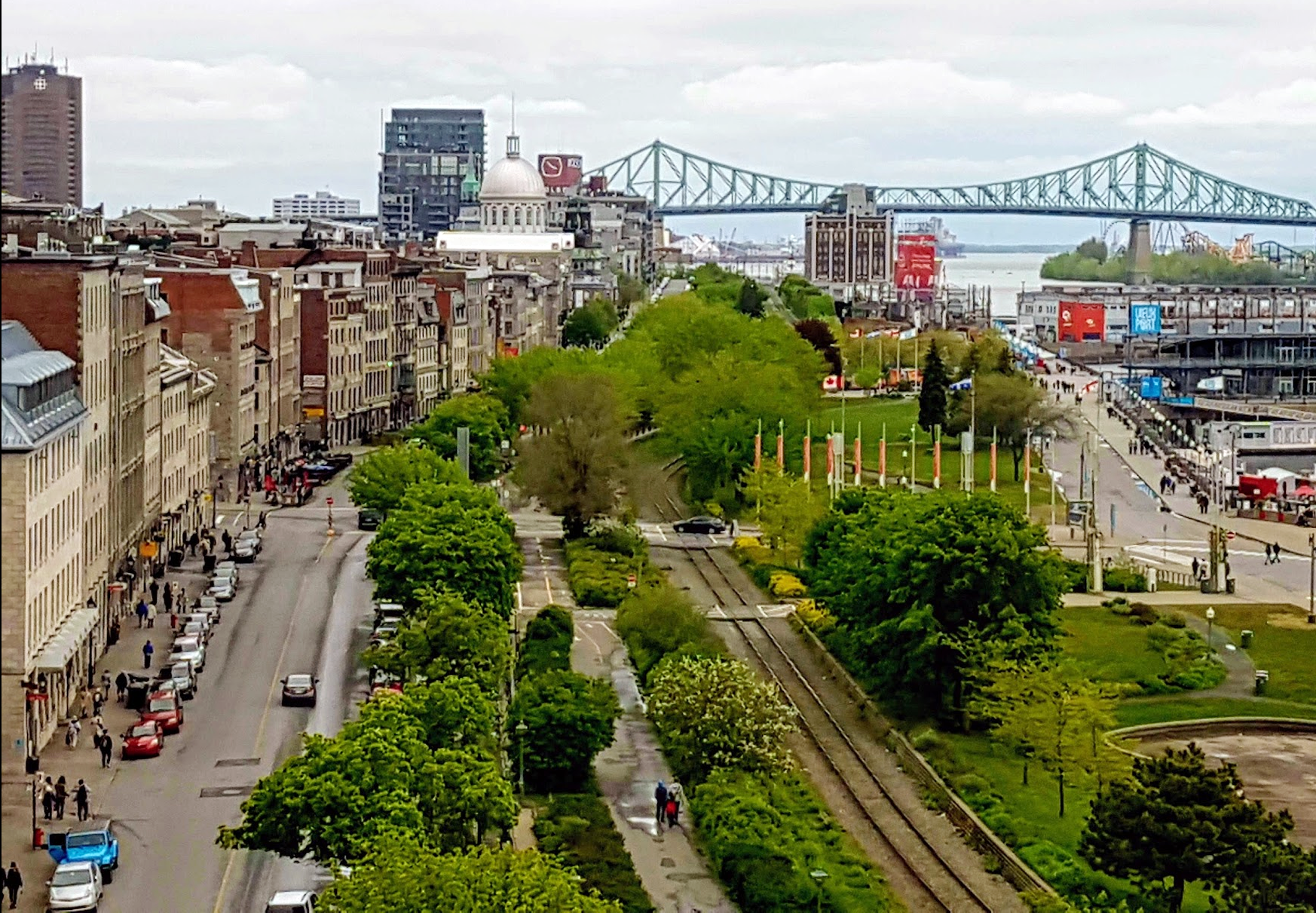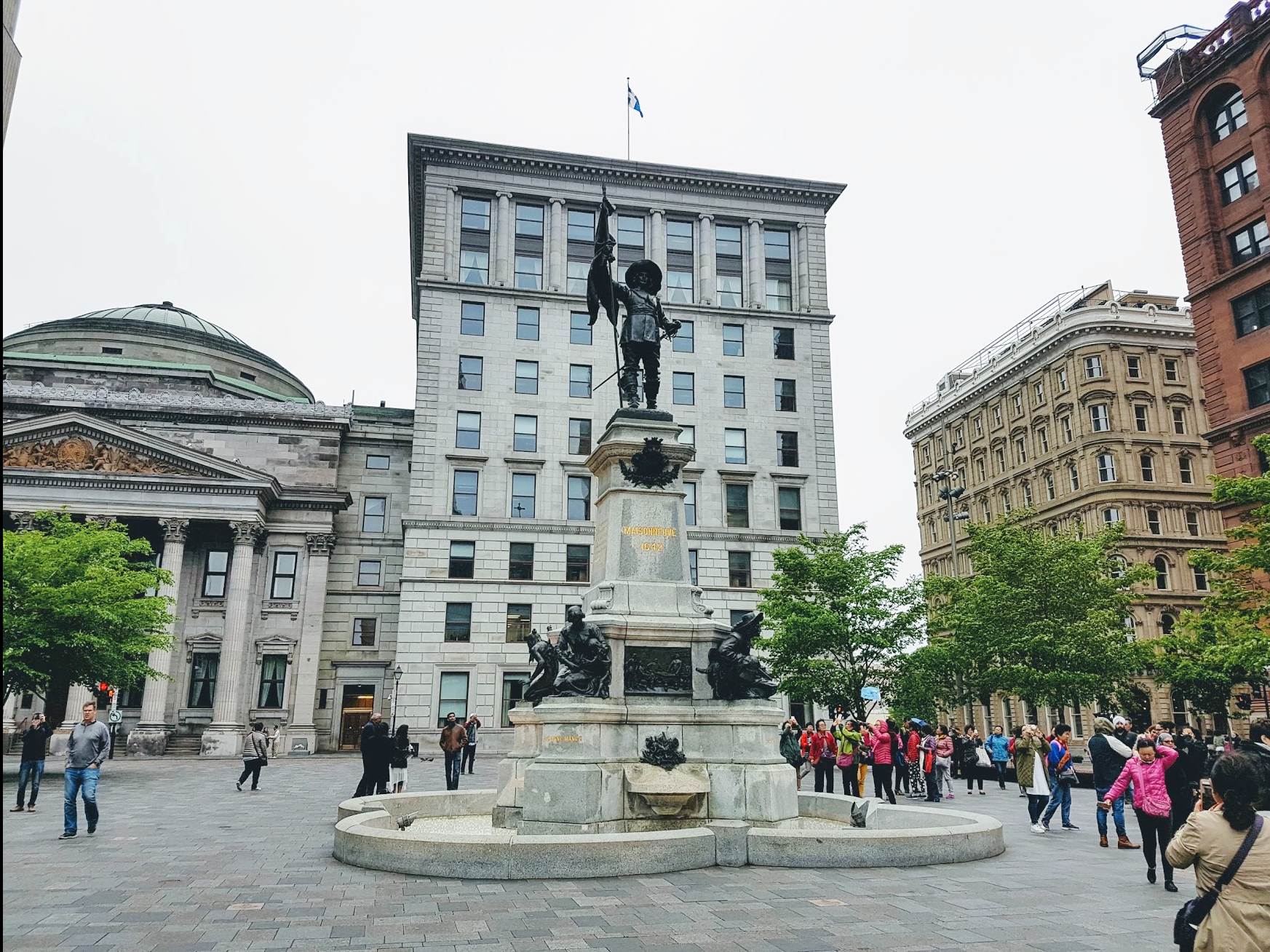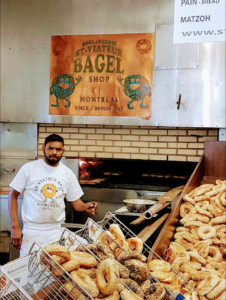Montreal is 375-Years Old and is Hosting a Year Long Birthday Party

Part of Historic Montreal with the Jacques Cartier Bridge in the background. Photo by Jacqueline Swartz
Montreal is celebrating its 375th birthday this year. The French-Canadian city on the St Lawrence River has long been known for its festivals, including the dramatic, mostly outdoor Festival of Lights in freezing February. But this year will be special. There will be street theatre performed by international groups, a convergence of three major orchestras, museum exhibits and sound and light shows throughout the year. One is called “Leonard Cohen, A crack in Everything, at the Musee d’art contemporain de Montreal.
The late poet/songwriter could only have come from Montreal. For here, in the world’s second-largest French speaking city, Cohen was exposed to both lyrical French songs and American country music. He grew up in a city that even in the 1950’s offered the European cafe experience, and a certain poetic melancholy.
According to Cohen’s song Suzanne, there’s a place by the river in Montreal where “the sun pours down like honey on our lady of the harbour”. The lady is the Star of the Sea, a statue of the Virgin Mary that crowns the 1678 Notre-Dame-de-Bonne-Secours church. Locals call it the Sailors’ Church since, in a characteristically Montreal way, Catholicism here is mixed with the edgy openness of a port city.
The other church called Notre Dame is the Basilica, a Montreal landmark, and the place where Celine Dion got married. To mark this year, digital designers at The Moment Factory, have come up with a spectacularly moving sound and light show inside the Basilica. With lights illuminating the interiors of this modern gothic church, and the sound of a choir and an organ, the show leaves its spectators wowed into silence.
The Basilica is located on Place d’Armes, a large plaza surrounded by buildings that tell the story of Montreal from its past to its present and onwards. Adjacent to the Notre Dame Basilica is the Seminary of the Sulpician Fathers, built in l685. Across the plaza is Canada’s first skyscraper, the l888 red-tinged New York Life building, and the Aldred building, a 1931 art deco gem that resembles the Empire State Building in New York. Nearby, Canada’s first bank, The Bank of Montreal has its head office here in an 1859 building.

Montreal founder Paul Chomedey de Maisonneuve stands at the center of the city’s Place d’Armes. Photo by Jacqueline Swartz
On the corner of rue Place d’Armes, in an l870’s building that once housed a life insurance company, sits Hotel Place D’Armes, the city’s first boutique hotel. It helped lead the revitalization of Old Montreal and continues to attract trendies and film crews shooting in Montreal; its rooftop Terrasse is open until 3am on weekends.
Nearby, on one of Old Montreal’s cobblestone streets, is rue Saint-Jacques, once called Canada’s Wall Street. By the 19th Century, Montreal had become Canada’s major financial center, evident today in one of the best-preserved business districts in North America. Here the opulent and ostentatious 19th century banks and insurance companies still stand, some repurposed as hotels and galleries, while others live on as restaurants.
As Montreal’s fortunes waned, the area became rundown and stayed that way until a few decades ago when it started moving from seedy to swank. There will be outdoor projections in Old Montreal during this birthday summer. You can download a free app in English, Montreal en Histoires.
The decades-long threat of separatism espoused by Quebec nationalists and the Parti Québécois had unintended benefits. Repeated secession threats created a stagnant economic atmosphere, prompted the flight of Anglophones to Toronto and put the city into a kind of construction deep freeze. Fortunately, the wrecker’s ball was stopped from destroying venerable old structures at a time when financing to build cookie cutter condos was not available. Now, biotechnology, multimedia and video game companies like Ubisoft are attracting tech workers, who can live well in this city of affordable housing and safe, walk able neighborhoods.
Montrealers consider themselves more American than Anglo-Canadians elsewhere in the country. The city is outgoing and pleasure-seeking. It is where Torontonians go (an express trains takes 5 hours) to have fun and pretend they’re in Europe. In Montreal, regulations are less about what time the bars close (late) and more about preserving heritage buildings. In 2005 it was named a UNESCO City of Design.
There is a turbo-charged restaurant scene, with innovative chefs taking a fresh look at French Canadian traditions – from game and local produce to award-winning cheese. Poutine, the local fast-food staple consisting of French fries covered in cheese curds and gravy, has been upgraded, sometimes with truffles. There’s even a restaurant called Vladimir Poutine. Other Montreal restaurants like Mercuri Montreal take advantage of the 50 farmer’s markets that are open between June and September.
With so much competition – Montreal is second only to New York in the number of restaurants per inhabitant in North America – standards are very high. And for US and European visitors, the Canadian dollar is low.
Where should you start exploring the city? Perhaps at the place is where Montreal began in 1642 when some forty pioneers arrived from France. The spot is marked by a distinctive, multi-level modern structure housing the Pointe-a-Calliere, the Montreal Archeology and History Complex. The lowest level, called the Crypt, is a constantly evolving archeological site. In a theatre, there’s a presentation describing Montreal’s history through projected images, film clips and photos. Like everything else you’ll need in Montreal, you can access it in English.
Don’t Miss:
* Across town from Old Montreal are the neighborhoods of Plateau Montreal and Mile End, the trendy, bohemian centers of the city. These low-rise neighborhoods are dotted with bars and boutiques, and multicolored houses with Montreal’s signature outdoor staircases. Here, especially on Saint-Denis St., are some of Montreal’s most creative clothing designers.
* Schwartz’s Delicatessen has served smoked meat for over 80 years and is famous all over Canada and beyond. And St. Viateur Bagels, using a wood oven, is a Montreal staple.
* Downtown Montreal’s St. Catherines St. is the city’s main shopping street, with the elegant department stores, Ogilvey’s and Holt Renfrew.
* The Museum of Fine Arts, on Sherbrooke Street, has a fine collection of painting and sculpture in a spacious light-filled building, with a sculpture walk across the street.
* Quartier du Canal. This happening part of the city, adjacent to Old Montreal, includes the Lichine Canal, where you can rent paddle boats or cycle on the boardwalk. Atwater Market is for shopping and lunching. And Little Burgundy is the neighborhood where African Americans lived and jazz clubs flourished. Today, it is home to a trendy street of restaurants.


